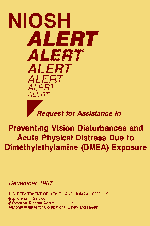Request for Assistance: Preventing Vision Disturbances and Acute Physical Distress Due to Dimethylethylamine (DMEA) Exposure
December 1987
DHHS (NIOSH) Publication Number 88-103

NIOSH requests assistance in preventing vision disturbances and acute physical distress due to dimethylethylamine (DMEA) exposure. This alert describes the results of a NIOSH investigation at an aluminum casting foundry where workers exposed to DMEA reported vision disturbances (blurred, foggy, and halo vision) and systemic effects (headache, nausea, and stomach pain) during coremaking operations. The vision disturbances and systemic effects occurred among workers exposed to DMEA at an 8-hour time-weighted average concentration equal to or greater than 6 milligrams per cubic meter of air (6mg/m3, or 2 parts per million [ppm]). The adverse health effects may also have been caused by 15-minute DMEA exposures as high as 29 mg/m3 (9.7 ppm). Acute physical distress and halo vision were experienced at concentrations higher than those associated with blurred vision only.
